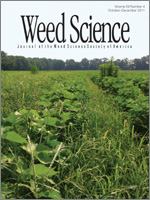Mesotrione, topramezone, and tembotrione inhibit 4-hydroxyphenylpyruvate dioxygenase (HPPD), an enzyme integral to carotenoid biosynthesis. Research was conducted to evaluate the response of hybrid bermudagrass following mesotrione (280, 350, and 420 g ai ha−1), topramezone (18, 25, and 38 g ai ha−1), and tembotrione (92, 184, and 276 g ai ha−1) applications. Measurements of visual bleaching (VB) and chlorophyll fluorescence yield (Fv/Fm) were evaluated 3, 5, 7, 14, 21, 28, and 35 d after application (DAA). Leaf tissues were sampled on the same dates and assayed for chlorophyll and carotenoid pigments using high-performance liquid chromatography (HPLC). Responses of plants treated with topramezone and tembotrione were similar; these herbicides caused more VB and greater reductions in Fv/Fm, total chlorophyll, lutein, and xanthophyll cycle pigment concentrations than mesotrione 5 to 21 DAA. Increasing mesotrione application rate did not increase VB or lead to greater reductions in total chlorophyll, lutein, or xanthophyll pigment concentrations. Alternatively, increasing topramezone and tembotrione application rates above 18 and 92 g ha−1, respectively, extended VB and pigment reductions. Of the three HPPD-inhibitors tested, topramezone was the most active, because the low (18 g ha−1) rate of topramezone reduced lutein and total xanthophyll pigment concentrations more than the low rate of tembotrione (92 g ha−1) during periods of maximum activity (14 to 21 DAA). No necrosis was observed with any of the treatments, suggesting tank mixtures of topramezone with other herbicides might be required to provide long-term control of hybrid bermudagrass.
Nomenclature: Mesotrione; topramezone; tembotrione; hybrid bermudagrass, Cynodon dactylon (L.) Pers. × C. transvaalensis Burtt-Davy ‘Tifway’.





